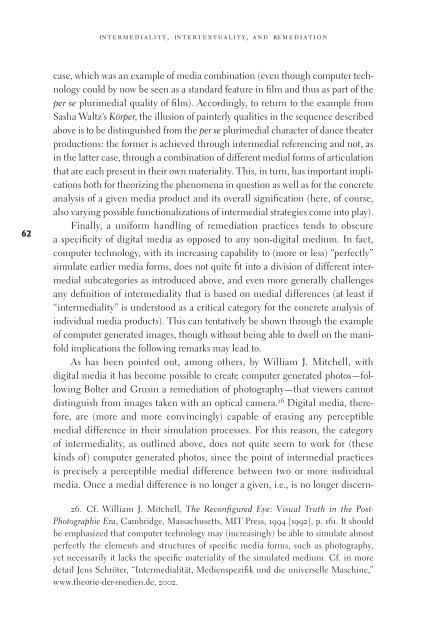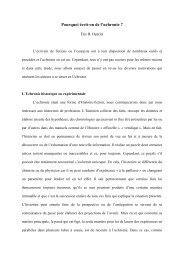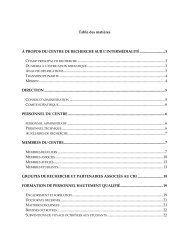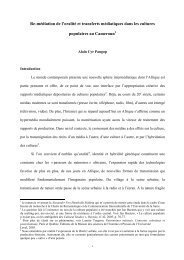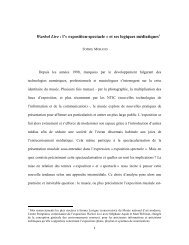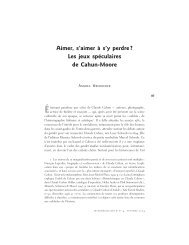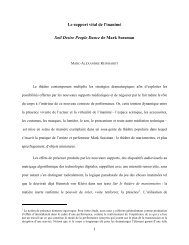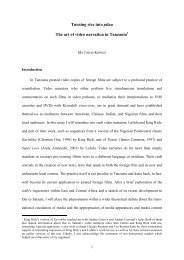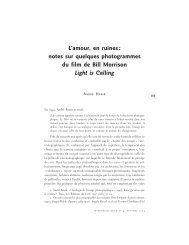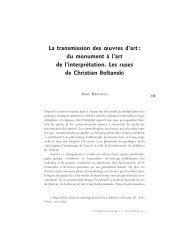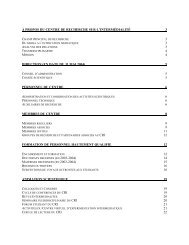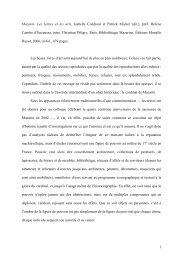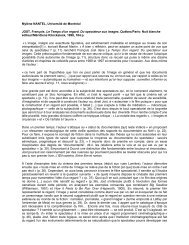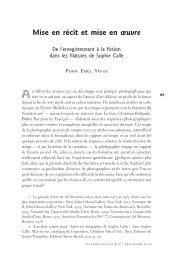Intermediality - Centre de recherche sur l'intermédialité (CRI ...
Intermediality - Centre de recherche sur l'intermédialité (CRI ...
Intermediality - Centre de recherche sur l'intermédialité (CRI ...
You also want an ePaper? Increase the reach of your titles
YUMPU automatically turns print PDFs into web optimized ePapers that Google loves.
62<br />
intermediality, intertextuality, and remediation<br />
case, which was an example of media combination (even though computer technology<br />
could by now be seen as a standard feature in fi lm and thus as part of the<br />
per se plurimedial quality of fi lm). Accordingly, to return to the example from<br />
Sasha Waltz’s Körper, the illusion of painterly qualities in the sequence <strong>de</strong>scribed<br />
above is to be distinguished from the per se plurimedial character of dance theater<br />
productions: the former is achieved through intermedial referencing and not, as<br />
in the latter case, through a combination of different medial forms of articulation<br />
that are each present in their own materiality. This, in turn, has important implications<br />
both for theorizing the phenomena in question as well as for the concrete<br />
analysis of a given media product and its overall signifi cation (here, of course,<br />
also varying possible functionalizations of intermedial strategies come into play).<br />
Finally, a uniform handling of remediation practices tends to obscure<br />
a specifi city of digital media as opposed to any non-digital medium. In fact,<br />
computer technology, with its increasing capability to (more or less) “perfectly”<br />
simulate earlier media forms, does not quite fi t into a division of different intermedial<br />
subcategories as introduced above, and even more generally challenges<br />
any <strong>de</strong>fi nition of intermediality that is based on medial differences (at least if<br />
“intermediality” is un<strong>de</strong>rstood as a critical category for the concrete analysis of<br />
individual media products). This can tentatively be shown through the example<br />
of computer generated images, though without being able to dwell on the manifold<br />
implications the following remarks may lead to.<br />
As has been pointed out, among others, by William J. Mitchell, with<br />
digital media it has become possible to create computer generated photos—following<br />
Bolter and Grusin a remediation of photography—that viewers cannot<br />
distinguish from images taken with an optical camera. 26 Digital media, therefore,<br />
are (more and more convincingly) capable of erasing any perceptible<br />
medial difference in their simulation processes. For this reason, the category<br />
of intermediality, as outlined above, does not quite seem to work for (these<br />
kinds of) computer generated photos, since the point of intermedial practices<br />
is precisely a perceptible medial difference between two or more individual<br />
media. Once a medial difference is no longer a given, i.e., is no longer discern-<br />
26. Cf. William J. Mitchell, The Reconfi gured Eye: Visual Truth in the Post-<br />
Photographic Era, Cambridge, Massachusetts, MIT Press, 1994 [1992], p. 161. It should<br />
be emphasized that computer technology may (increasingly) be able to simulate almost<br />
perfectly the elements and structures of specifi c media forms, such as photography,<br />
yet necessarily it lacks the specifi c materiality of the simulated medium. Cf. in more<br />
<strong>de</strong>tail Jens Schröter, “Intermedialität, Medienspezifi k und die universelle Maschine,”<br />
www.theorie-<strong>de</strong>r-medien.<strong>de</strong>, 2002.


